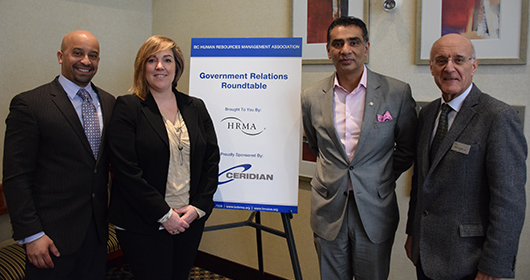Government Relations Roundtable Hits the Road
By Diane Taylor, CHRP
It was a full house on Friday, March 14th in Surrey, where the BC HRMA Fraser Valley region hosted the first regional Government Relations Roundtable with Hon. Amrik Virk, Minister of Advanced Education. The group in attendance consisted of several senior human resources professionals from diverse companies and organizations as well as representatives from post-secondary institutions in the Fraser Valley. Also in attendance was Julia Good representing Ceridian, the gracious sponsor for the Government Relations Roundtables.
“It was great to see such a large group out today,” said Simon Evans, CHRP, CEO of BC HRMA. “I am thrilled that we are bringing this out to the regions as the value in our association is found in the whole.”
One of BC HRMA’s strategic initiatives involves raising the profile and value of our profession. As a result, the initiative of hosting Government Relations Roundtables began in 2012. To date, there have been five roundtables with different honourable guests to dialogue with our members on various issues. As our association represents a highly diverse landscape of professionals in different regions with different challenges, the decision was made to expand this opportunity beyond the downtown office. The Surrey event marks the beginning of Government Relations Roundtables that will travel to our various regions.
“Our association represents a very diverse collection of industries and to see that represented here today enhances BC HRMA’s brand and knowledge base. By harnessing partnerships and breaking down silos between industry, academic institutions and government there is much to be gained for the future of our labour market,” said Dee Sharma, CHRP incoming chair for BC HRMA’s Fraser Valley Advisory Council.
Minister Virk began this roundtable with an informative presentation on his portfolio and the government’s strategy to re- engineer post-secondary education to ensure the public sees value and thoughtfully align advanced education with workforce needs in British Columbia. With 1M jobs to fill in our province between now and 2020 a diligent and innovative approach is required. A thorough forecasting process is being implemented to ensure we produce the right people, with the right education and skills for the right jobs at the right time. He spoke to some of the initiatives including aligning final high school years with post-secondary learning, employer partnerships with post-secondary institutions as a solution for filling hard-to-fill remote northern trades and technology positions, ‘adult re-tooling,’ and a program that is successfully being implemented in Alberta called Helmuts to Hardhats that retrains Canadian and American soldiers when they return home. He also spoke to cost savings resulting from a centralized procurement approach among post-secondary institutions that had resulted in a $6M savings in IT alone.
After the Minister’s presentation some very important and thought provoking discussion began. Some of the topics of discussion included:
- The viability and structure of the Industry Training Association (ITA). Minister Virk addressed how it will be reinvented to be more flexible and proactive. He also spoke to the desire to align what are currently 13 different models of trades training in Canada.
- There was a discussion on the ultimate purpose of advanced education. Should it be for the purpose of learning or for the purpose of getting a job? How do we bring together post-secondary faculty, employers and government funding to ensure the highest good for all stakeholders?
- A question was raised in response to the apparent focus on trades and technology as well as remote locations in the province. If 70 per cent of the positions are within the Greater Vancouver area and there is still a need for many traditional roles that require traditional degrees like Arts and Business, how is the government supporting those needs? Minister Virk addressed this concern by ensuring that they are responding to all labour and employment needs in the province and that a balanced approach is critical. He noted, for example, that Emily Carr just received $130M in funding to move to a new campus ensuring employer needs are being met in the areas of arts, design and graphics.
- A discussion was held around the recognition of foreign credentials in Canada. The control and approval process lies in the hands of the professional associations rather than the government; however, much progress with online credential review, approval and upgrading is being made in several associations.
- A question was raised regarding how we are enabling our First Nations to be a part of the workforce solution. The Minister spoke to the governments philosophy of providing a “hand up rather than a hand out” with post-secondary scholarships specifically for First Nations as well as taking education to them with mobile education units.
The first regional Government Relations Roundtable in the Fraser Valley was a huge success as the result of the participation and open discussion between Minister Virk, employers and post-secondary institutions. It promises to bring our membership much value as the dialogue continues in other regions.
“I am very encouraged that our senior practitioners have taken time from their schedules to engage in this dialogue with government.” said Christian Codrington, CHRP, senior manager of professional practice with BC HRMA. ”These exchanges raise the profile of the profession, inform our members on government initiatives and help to shape the context within which our membership must operate.”
Diane Taylor is a leadership and life design coach with 20 years of corporate HR experience. As principal of Glow Leadership, her purpose is to help people create meaningful balance by becoming leaders in all areas of their lives.








